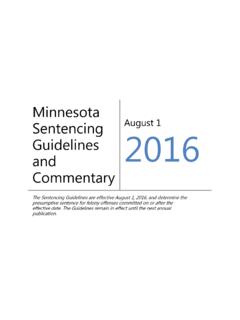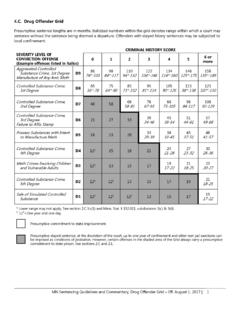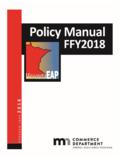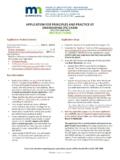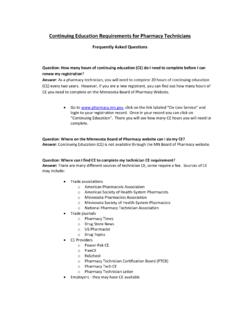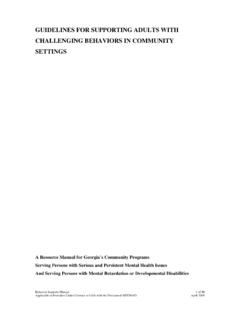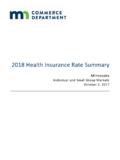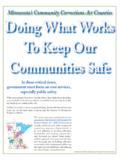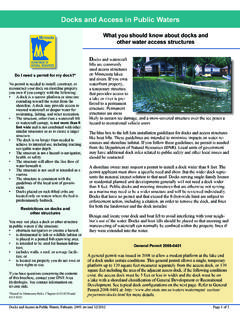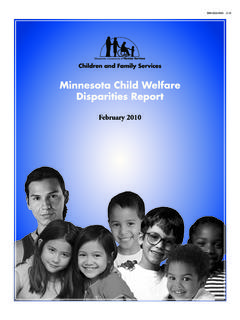Transcription of This Action Plan - mn.gov
1 2 This Action Plan is an overview of state government s actions to address the opioid epidemic state agencies are working collaboratively with other partners to develop a comprehensive strategic plan. You can learn more about those efforts by visiting the websites listed in the Resources section of this Action Plan on page 35. This Action Plan is a joint product of agencies that lead the State of Minnesota s actions to address the opioid epidemic: Minnesota Department of Health, Minnesota Department of Human Services, Minnesota Department of Corrections, and Minnesota Department of Public Safety. This Action Plan also details the state s organizational approach to this public health crisis. Management Analysis and Development, a management consulting group housed in Minnesota Management and Budget, compiled information from these agencies and facilitated discussions with leaders and policy experts to develop the content in this Action Plan.
2 3 ..5 ..6 ..6 ..6 ..7 ..7 ..8 ..9 .. 10 .. 11 .. 13 .. 14 .. 14 .. 16 .. 17 .. 18 .. 19 .. 19 .. 20 .. 20 .. 20 .. 21 .. 21 .. 22 .. 22 4 .. 22 .. 24 .. 26 .. 26 .. 27 .. 27 .. 28 I .. 29 .. 30 .. 30 .. 31 .. 31 .. 31 .. 32 .. 33 .. 33 .. 35 5 Every year, thousands of Minnesotans become addicted to opioids, and hundreds of them lose their lives due to their addictions. This epidemic has devastated individual lives, families, schools, and entire communities. The Minnesota Opioid Action Plan was developed in partnership with law enforcement officials, health care providers, community organizations, and in consultation with our federal counterparts. The Action Plan outlines new strategies that state government and local partners can implement to curb opioid abuse and save lives everywhere in our state. Our Administration has already taken aggressive steps to reduce the flow of illicit opioids, improve treatment options, and support the people and areas affected.
3 But we must do far more to save lives and reduce the terrible harm to our communities. We must take decisive Action in this Legislative Session to reduce abuses and to ensure that all Minnesotans suffering from these addictions receive the treatment and support they need. I look forward to working with the Legislature to enact these broadly-supported and urgently-needed initiatives. Sincerely, Mark Dayton Governor 6 Opioids1 can be an important tool to relieve pain but opioids also can be misused. People can become dependent or addicted to opioids, and misuse of opioids can lead to dangerous and deadly overdoses. The dramatic increase in deaths associated with opioid abuse in recent years is a public health crisis: from 1999 to 2015, the number of deaths involving opioid drugs quadrupled in the United States to over 30,000 in Minnesota s death rates are lower than many other states, but opioids are a significant problem in Minnesota.
4 Opioid misuse is harming Minnesota communities: people are dying from overdoses, children are being separated from their parents, law enforcement officers are at risk, treatment providers and community organizations are under-resourced, and communities and families are suffering. The opioid epidemic in Minnesota requires special attention, but state leaders, local officials, and community organizations have noted connections in problems such as suicide, homicide, and substance abuse. There are even deeper root causes of social determinants of health that could be addressed through comprehensive prevention efforts. Integration of our efforts (state agencies, local government, community organizations, and providers) and attention to collective impact will be critical as we address these problems. We are focused now on actions that will address the opioid epidemic, and we do so within our existing work on substance abuse and other public health issues.
5 You can learn more about the State of Minnesota s work in these areas by visiting the websites listed in the Resources section on page Error! Bookmark not defined. of this report. Our two-part goal is to save lives and prevent harm caused by opioids in Minnesota. Saving lives and preventing harm means taking positive Action on several levels at the same time: for individuals, communities, and the state as a whole. We re taking Action along a whole continuum to prevent misuse and addiction, to respond to emergency situations, to increase and improve treatment and recovery programs, and to enforce the law. To save lives and prevent harm, we re working across state government, continuing our current work and expanding our collaborative efforts. We ll need to expand our efforts inside state government and with other partners, and we ll need support from the Minnesota Legislature to succeed. 1 The term opioids includes a range of substances that act on the brain s opioid receptors: natural (opium), semi-synthetic (hydrocodone, oxycodone), and synthetic (fentanyl, fentanyl analogs).
6 2 Data from Centers for Disease Control, 7 To monitor our progress, we ll track key population indicators. In the next section, we outline those data points and trends that tell a lot about the opioid epidemic in Minnesota. Later sections of this report describe how we re providing leadership on opioids, our current actions, and our future plans. We can track our impact on the opioid epidemic in Minnesota by tracking key statewide indicators. State government programs and policies aren t the only relevant factors in these trends, but we know our work must contribute to positive changes (that is, to turn the data curve in a better direction) in these areas: Opioid overdose deaths: We want to see these numbers go down over time, so that we move towards zero deaths due to opioids. (Go to page 7 for more information about this indicator.) Disparities in overdose deaths for African Americans and American Indians: We want to see the overall numbers of deaths in all communities go down, and we want disparities to be reduced and eliminated (Go to page 8 for more information about this indicator.)
7 Opioid prescribing rates: We want to see these numbers go down over time as providers and patients use alternatives to opioids whenever possible. (Go to page 9 for more information about this indicator.) Heroin and prescription drug arrests: We want to see these numbers go up initially as law enforcement officials get dangerous substances out of communities, but we ultimately want to see these numbers go down as fewer people use these substances. (Go to page 10 for more information about this indicator.) Out of home placements connected to opioid misuse: We want to see these numbers go down as fewer families are disrupted due to opioid misuse. (Go to page 11 for more information on this indicator.) Death is the most visible harm associated with the opioid epidemic. Opioid overdose deaths continue to rise in Minnesota. Prescription opioids account for the greatest number of overdose deaths in Minnesota, but since 2010, heroin-involved deaths have increased in Minnesota; between 2015 and 2016, fentanyl-involved deaths have increased.
8 In 2016, there were: 395 total opioid overdose deaths an 18% increase since 2015. 194 overdose deaths that involved prescription opioids. 150 overdose deaths that involved heroin. The chart below shows the increase in opioid-involved overdose deaths in Minnesota. The dark blue line shows the number of all opioid overdose deaths (395 in 2016). The green line shows the number of deaths due to commonly prescribed opioids such as codeine, oxycodone, and methadone (194 in 2016). The red line shows the number of heroin overdoses (150 in 2016) and the orange line shows the number of deaths from a broad 3 Data in this section is from the state s opioid dashboard, located here: 8 category of synthetic opioids (99 in 2016). (Note: The detailed death counts add up to more than 395 because some deaths involve multiple drugs and the drug categories are not mutually exclusive each death is counted only once in the total.)
9 Opioids and other drugs have been especially harmful in tribal communities and communities of color in Minnesota. In 2015, American Indian Minnesotans were five times more likely to die from a drug overdose than white Minnesotans, and African American Minnesotans were two times more likely to die from a drug overdose than white Minnesotans. Both of these rate disparities between American Indians/whites and African Americans/whites are highest rates of such disparities in the United States. Final 2016 data show the disparities have continued and worsened. While the white drug overdose mortality rate increased from to per 100,000 white residents, the American Indian mortality rate increased from per 100,000 residents to per 100,000 residents, and the African American rate increased from per 100,000 residents to per 100,000 residents (the chart below shows this data). Although national 2016 4 Data in this section is from the state s opioid dashboard, located here: 9 mortality data are not yet available, Minnesota s racial disparity rates for overdose deaths are likely to remain among the highest in the United States.
10 *Note: Above graph is for all drug overdoses, including opioids, methadone, heroin, synthetic opioids, cocaine, psychostimulants, and benzodiazepines Opioids come from several sources: (1) prescriptions written to a patient, (2) unused prescriptions shared with family and friends, (3) unused or diverted prescriptions sold on the street, (4) counterfeit prescriptions manufactured at pill mills, and (5) heroin and other illicit substances. In Minnesota, more than million opioid prescriptions were reported as dispensed in 2016. The top three most frequently prescribed opioids were hydrocodone/acetaminophen, oxycodone, and tramadol. There was roughly an reduction in opioid prescriptions dispensed from 2015 to 5 Data in this section is from the state s opioid dashboard, located here: Data is reported through the Prescription Monitoring Program, which may be incomplete read more about data limitations here: #NumberPrescriptions 10 Opioid prescribing rates increased in Minnesota and nationally from 2006 to 2012, and have been declining since then, as shown in the chart below.


